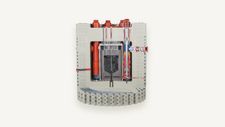
Shattered Nuclear Dreams
Fear of energy shortages and faith in technological advances awakened enthusiasm for nuclear power, and North Rhine-Westphalia was no different. Near Jülich, a nuclear research facility with test reactors was built and in the 1960s the building of nuclear power plants was first considered.
The solution to energy woes was to be the pebble bed reactor. This technology is a home-grown product of North Rhine-Westphalia: the reactor’s prototype was developed in Jülich and its inventor was the Münsterland-born physicist Rudolf Schulten. Following in the footsteps of his preliminary work, an operating company planned the construction of a so-called thorium high-temperature reactor (THTR for short) in Hamm, Westphalia.
The distinctive feature of the THTR is the design of its pebble bed. The atomic fuel is packed into heatproof graphite spheres a few centimetres in diameter – roughly 670,000 of these black pebbles comprise the reactor core. They allow the nuclear fission process to be controlled. The heat produced by this process is used to generate electricity. However, the complex mechanism was susceptible to faults and the pebbles would frequently break.
After a lengthy, error-prone planning phase, the Hamm reactor went into commercial service in 1987. However, technical issues forced it temporarily out of operation just two years later. The public mood in the state had changed by this point: citizens’ initiatives protested against the THTR and its operating company was in financial difficulties. The reactor closed for good in 1989 – its radioactive leftovers await a solution in spent nuclear fuel containers to this day.